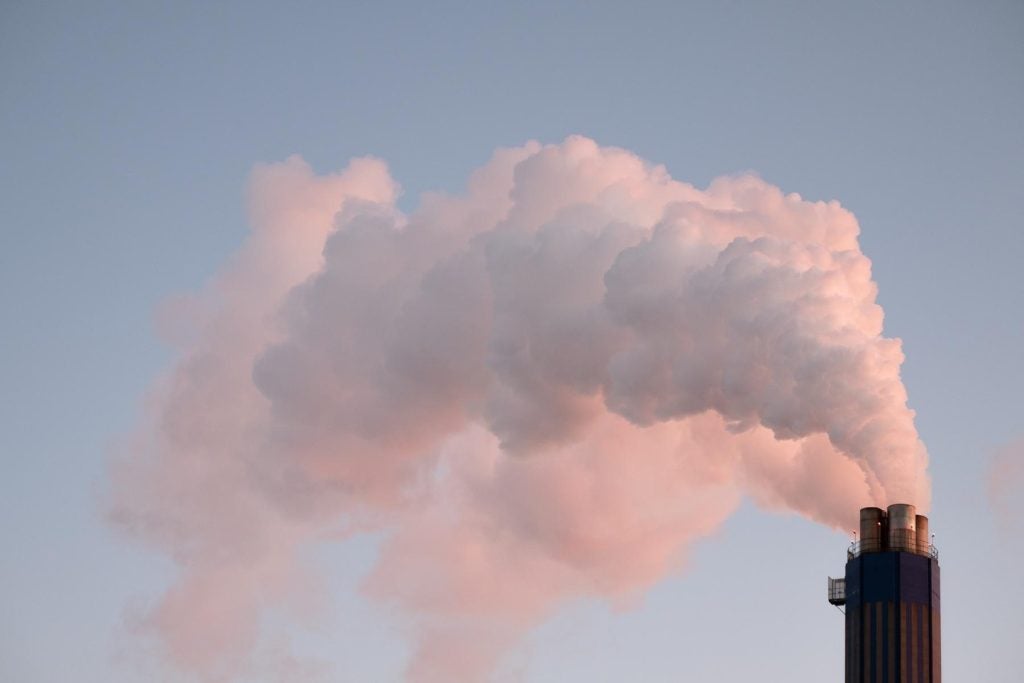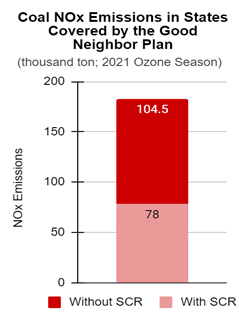EPA’s Good Neighbor Rule will protect millions of people from poorly-controlled smokestack pollution
 (This post was co-authored by EDF analyst Jolie Villegas)
(This post was co-authored by EDF analyst Jolie Villegas)
The U.S. Environmental Protection Agency (EPA) just finalized its Good Neighbor Plan this month and that means millions of people in downwind states will be protected from unhealthy smokestack pollution that blows across state lines.
The new plan will significantly reduce smog-forming nitrogen oxides (NOx) pollution from fossil fuel power plants and industrial sources in 23 states.
EPA’s action addresses an urgent problem: NOx pollution from power plants without modern pollution controls. As depicted below, well over half of the NOx pollution from coal units in states covered by the Good Neighbor Plan is from coal units without modern pollution controls.

Graphic: EDF
The Good Neighbor Plan controls harmful interstate pollution
Power plants and numerous industrial sources emit harmful NOx pollution when fossil fuels are burned. NOx is a key ingredient in ground-level ozone, what is widely known as “smog.” Smog damages people’s lungs and is linked to asthma attacks and other serious lung and heart diseases. Smog is especially harmful to children, the elderly, and people who are active outdoors.
According to the American Lung Association, in 2020, more than 122 million people lived in counties with unhealthy smog levels. That’s 3 in every 8 people in America.
Wind can transport smog-forming NOx far from the pollution source and across state borders. The Clean Air Act’s Good Neighbor safeguards are designed to address this problem and protect people in downwind states from pollution they can’t control. EPA’s just-finalized plan reduces NOx pollution from smokestacks in 23 upwind states, which will help downwind states meet their clean air obligations under the health-based 2015 National Ambient Air Quality Standards for ozone.
The Clean Air Act requires the EPA to control interstate pollution
The Clean Air Act requires that upwind states eliminate emissions that significantly contribute to unhealthy levels of pollution in downwind states. If an upwind state fails to meet these Good Neighbor obligations through an adequate state plan, the Clean Air Act requires that the EPA publish a Federal Implementation Plan to safeguard the millions of people who live in downwind states.
EPA has a long history of protecting people under the Good Neighbor provision of the Clean Air Act across Republican and Democratic administrations, including the NOx SIP Call (1998), the Clean Air Interstate Rule (2005), the Cross-State Air Pollution Rule (2011), and updates to the Cross-State Air Pollution Rule in 2016 and 2021. (A unanimous panel of judges on the U.S. Court of Appeals for the D.C. Circuit recently upheld the latest update in the face of a challenge from some coal-based power companies. You can read more about that here.)
In the Good Neighbor Plan, EPA is requiring emissions reductions from power plants and other industrial sources through a phased-in approach:
- Beginning in this year’s ozone season, emissions budgets will be set at the level of reductions achievable through the operation of emissions controls already installed at power plants.
- In 2024, state budgets are set based on additional emission reductions achieved through combustion control upgrades at units in certain states.
- Emissions reductions from industrial sources will be required starting in 2026.
- Throughout 2026 and 2027, budgets will be set at levels achieved by installing selective catalytic reduction controls (SCR) – a widely available and long-established modern pollution control for NOx – at large coal-fired power plants and certain large gas-fired power plants that currently do not have these modern pollution controls, in addition to selective non-catalytic reduction (SNCR) at smaller coal-fired units.
The plan also includes phased-in dynamic budgeting and phased-in daily emissions rate limits to ensure that large coal-fired units are operating SCR controls during the ozone season.
An analysis by EDF found that, for a number of states covered by the new plan, thousands of tons of NOx pollution are from coal-fired units without modern pollution controls during the 2021 ozone season. For example:
- In Texas, 23 coal units without SCR (out of 31 total coal units) accounted for 22,000 tons of NOx emissions during the 2021 ozone season.
- In Utah, 8 coal units without SCR (out of 8 total coal units) accounted for 15,500 tons of NOx emissions during the 2021 ozone season.
- In Missouri, 11 coal units without SCR (out of 21 total coal units) accounted for 8,200 tons of NOx emissions during the 2021 ozone season.
In states covered by the Good Neighbor Plan, almost 2/3 of the nation’s large fleet of coal-fired power plants has installed SCR. Installation of widely available and long-established modern pollution control technology for the other 1/3 of the coal fleet is long overdue.
EPA’s Good Neighbor Plan contains significant public health benefits
The clean air protections in the Good Neighbor Plan are vital for the people that live in the shadows of those coal plants and that live many miles downwind.
The Good Neighbor Plan will provide immediate protections for human health. This year (2023) EPA projects the rule will prevent 110,000 asthma attacks.
In 2026, the plan’s reduction of smog-forming pollution is projected to annually prevent approximately:
- 1,000 premature deaths
- 6,600 cases of asthma onset
- 2,000 hospital emergency room visits for breathing problems
- 1.2 million asthma attacks
EPA’s plan’s net annual monetary benefits (after any costs) are expected to total $200 billion over the implementation of these protections.













One Comment
I am curious as to why only SCR control methods are recommended requiring energy hungry heat systems whereas “Ozone generation” requiring no heat source and applied correctly can drastically reduce costs, be as effective as heat/steam and is easily implimented.